Azure Active Directory with Azure Kubernetes Service
Azure Kubernetes Service (AKS) can be configured to use Azure Active Directory (AD) for user authentication. In this configuration, you can log into an AKS cluster using an Azure AD authentication token. Cluster operators can also configure Kubernetes role-based access control (RBAC) based on a user's identity or directory group membership.
Azure AD can only be enabled when you create a new, RBAC-enabled cluster. You can't enable Azure AD on an existing AKS cluster.
When configuring Azure AD for AKS authentication, two Azure AD application are configured. This operation must be completed by an Azure tenant administrator.
Following are the steps to deploy AKS (Azure Active Directory) with AAD (Azure Active Directory):
- Create Azure AD Server Component
- Create Azure AD Client COmponent
- Deploy the cluster
- Create RBAC binding
- Access the cluster with Azure AD
All commands below will be run using Azure CLI. Install Azure CLI here
Create Azure AD Server Component
Define a name for your cluster:
aksname="myakscluster"
Create the server application component:
# Create the Azure AD application
serverApplicationId=$(az ad app create \
--display-name "${aksname}Server" \
--identifier-uris "https://${aksname}Server" \
--query appId -o tsv)
# Update the application group memebership claims
az ad app update --id $serverApplicationId --set groupMembershipClaims=All
Now create a service principal for the server app:
# Create a service principal for the Azure AD application
az ad sp create --id $serverApplicationId
# Get the service principal secret
serverApplicationSecret=$(az ad sp credential reset \
--name $serverApplicationId \
--credential-description "AKSPassword" \
--query password -o tsv)
Add Permissions using the following command for:
- Read directory data
- Sign in and read user profile
az ad app permission add \
--id $serverApplicationId \
--api 00000003-0000-0000-c000-000000000000 \
--api-permissions e1fe6dd8-ba31-4d61-89e7-88639da4683d=Scope 06da0dbc-49e2-44d2-8312-53f166ab848a=Scope 7ab1d382-f21e-4acd-a863-ba3e13f7da61=Role
Finally, grant the permissions assigned in the previous step for the server application:
az ad app permission grant --id $serverApplicationId --api 00000003-0000-0000-c000-000000000000
az ad app permission admin-consent --id $serverApplicationId
Create Azure AD Client component
Create the Azure AD app for the client component:
clientApplicationId=$(az ad app create \
--display-name "${aksname}Client" \
--native-app \
--reply-urls "https://${aksname}Client" \
--query appId -o tsv)
Create a service principal for the client application:
az ad sp create --id $clientApplicationId
Get the oAuth2 ID for the server app to allow the authentication flow between the two app components:
oAuthPermissionId=$(az ad app show --id $serverApplicationId --query "oauth2Permissions[0].id" -o tsv)
Add the permissions for the client application and server application components to use the oAuth2 communication flow:
az ad app permission add --id $clientApplicationId --api $serverApplicationId --api-permissions $oAuthPermissionId=Scope
az ad app permission grant --id $clientApplicationId --api $serverApplicationId
Deploy the Cluster
With the two Azure AD applications created, now create the AKS cluster itself. First, create a resource group:
az group create --name myResourceGroup --location EastUS
Get the tenant ID of your Azure subscription using:
tenantId=$(az account show --query tenantId -o tsv)
az aks create \
--resource-group myResourceGroup \
--name $aksname \
--node-count 5 \
--generate-ssh-keys \
--aad-server-app-id $serverApplicationId \
--aad-server-app-secret $serverApplicationSecret \
--aad-client-app-id $clientApplicationId \
--aad-tenant-id $tenantId
Finally, get the cluster admin credentials:
az aks get-credentials --resource-group myResourceGroup --name $aksname --admin
Create RBAC binding
Before an Azure Active Directory account can be used with the AKS cluster, a role binding or cluster role binding needs to be created. Roles define the permissions to grant, and bindings apply them to desired users. These assignments can be applied to a given namespace, or across the entire cluster. For more information, see Using RBAC authorization.
Get the user principal name (UPN) for the user currently logged in:
az ad signed-in-user show --query userPrincipalName -o tsv
Create a YAML manifest named basic-azure-ad-binding.yaml and paste the following contents. On the last line, replace userPrincipalName_or_objectId with the UPN or object ID output from the previous command:
apiVersion: rbac.authorization.k8s.io/v1
kind: ClusterRoleBinding
metadata:
name: cluster-admins
roleRef:
apiGroup: rbac.authorization.k8s.io
kind: ClusterRole
name: cluster-admin
subjects:
- apiGroup: rbac.authorization.k8s.io
kind: User
name: userPrincipalName_or_objectId
Create the ClusterRoleBinding:
kubectl apply -f basic-azure-ad-binding.yaml
Verify cluster with Azure AD
Test the integration of Azure AD authentication for the AKS cluster. Set the kubectl config context to use regular user credentials. This context passes all authentication requests back through Azure AD.
az aks get-credentials --resource-group myResourceGroup --name $aksname --overwrite-existing
Test by getting pods:
kubectl get pods --all-namespaces
You receive a sign in prompt to authenticate using Azure AD credentials using a web browser. After you've successfully authenticated, the kubectl command displays the pods in the AKS cluster.
Configure KeyCloak with Microsoft Azure Active Directory
- Create Users in Azure using the Administrator account using the this. The new Users will be shown as source Azure Active Directory as below
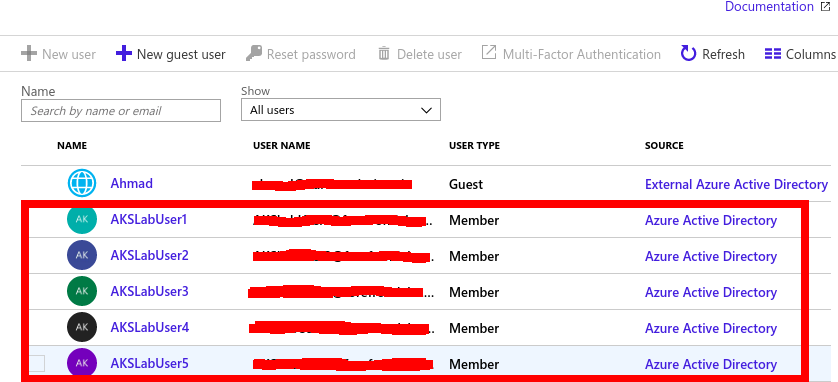
- Go to your Azure AD instance, select App Registrations on the left panel and click Endpoints on the top panel displayed. Copy values for OAuth 2.0 authorization endpoint (v2) and OAuth 2.0 token endpoint (v2) values. these will be used in the Keycloak configurations.
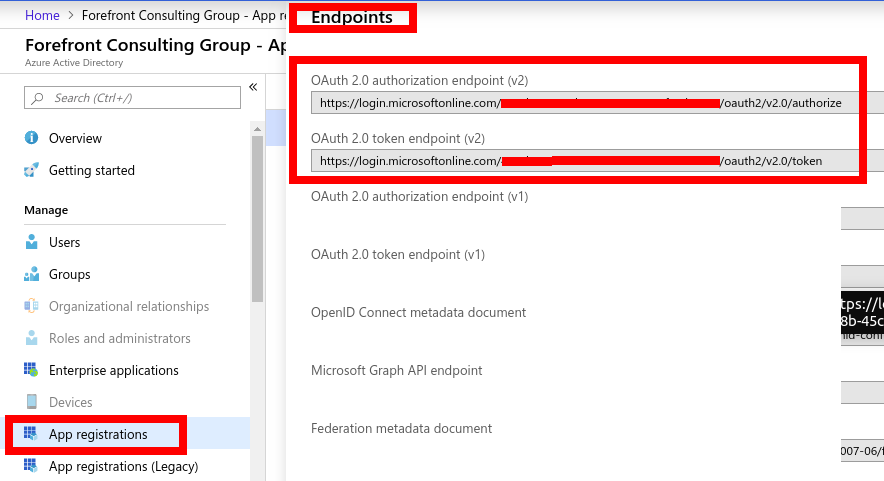
- Go to your Azure AD instance, select App Registrations on the left panel and Select Azure AD Client Application created when Azure Active directory was created. Copy the Application (client) ID.
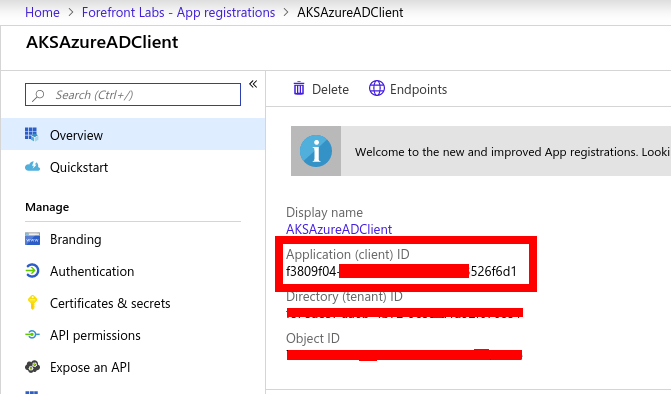
- Click Certificates and Secrets from the left panel and click New Client Secret button and create a new secret. Copy the value of the secret.
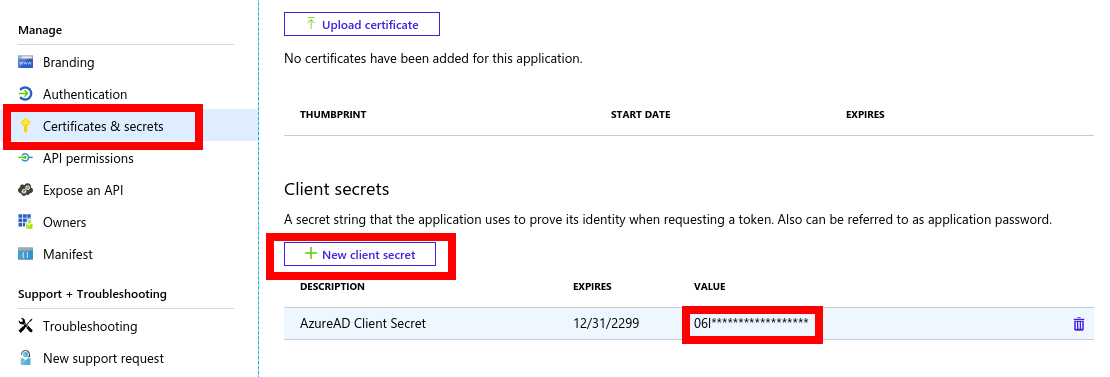
After the users are created open Keycloak administrative console and Select Identity Providers in the left panel.
Click on the Add Provider drop down and select OpenID Connect v1.0
Fill in the Options as below:
- alias: azure-ad
- Display Name: Microsoft Azure AD
- First login flow: first broker login
- Authorization URL: (OAuth 2.0 authorization endpoint (v2))
- Token URL: (OAuth 2.0 token endpoint (v2))
- Client ID: (Application (client) ID) from step 3
- Client secret: client secret from step 3
- Prompt: unspecified
Click Save to create the OIDC type Identity Provider. Final configurations:
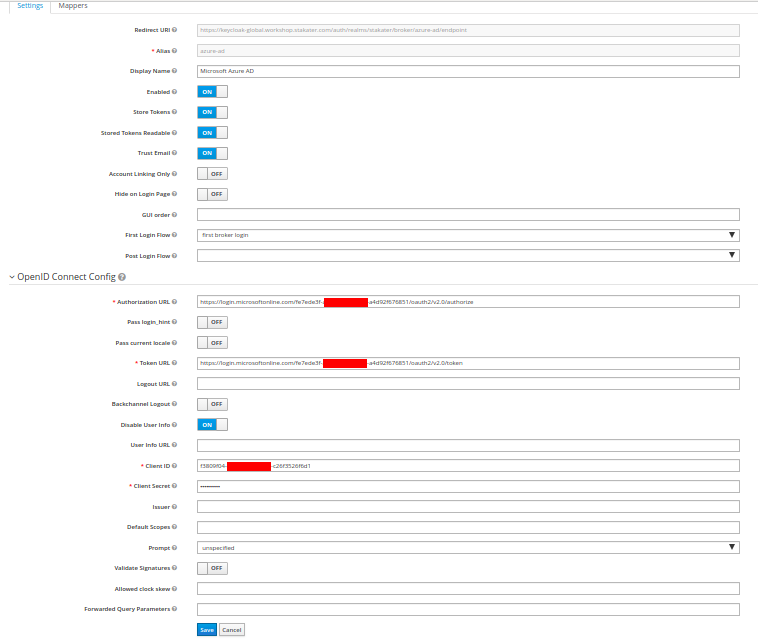
Copy the Redirect URI form the created Identity Provider. In Azure AD instance go to App Registration, Select AD Client application, select Authentication, and paste this URI in Redirect URI field and type Web and click the add button to add.

- Open any application that uses KeyCloak in browser to test Keycloak is working fine with Azure AD.
Access Control using RBAC
When AKS cluster is deployed only admin has full access to the cluster. So we need to use the az aks get-credentials command with the --admin argument to sign in to the cluster with admin access.
az aks get-credentials --resource-group myResourceGroup --name $aksname --admin
In order to give a user permission to list pods. we need to create a Role and then create a ClusterRoleBinding for that user.
A role pod-reader which can get, watch and list pods:
kind: Role
apiVersion: rbac.authorization.k8s.io/v1
metadata:
namespace: default
name: pod-reader
rules:
- apiGroups: [“”] # “” indicates the core API group
resources: [“pods”]
verbs: [“get”, “watch”, “list”]
A ClusterRoleBinding which will bind a user to the role pod-reader:
apiVersion: rbac.authorization.k8s.io/v1beta1
kind: ClusterRoleBinding
metadata:
name: user-view
roleRef:
apiGroup: rbac.authorization.k8s.io
kind: ClusterRole
name: view
subjects:
- kind: User
name: <USER_ID_FROM_AZURE_ACTIVE_DIRECTORY>
apiGroup: rbac.authorization.k8s.io
apply these configurations using kubectl apply -f command.
Now the user with <USER_ID_FROM_AZURE_ACTIVE_DIRECTORY> ID will have a restricted access to list watch and get pods. Similarly other access controls can be applied on Services, Pods and other resources etc. using RoleBinding/ClusterRoleBinding on Roles as per requirement.